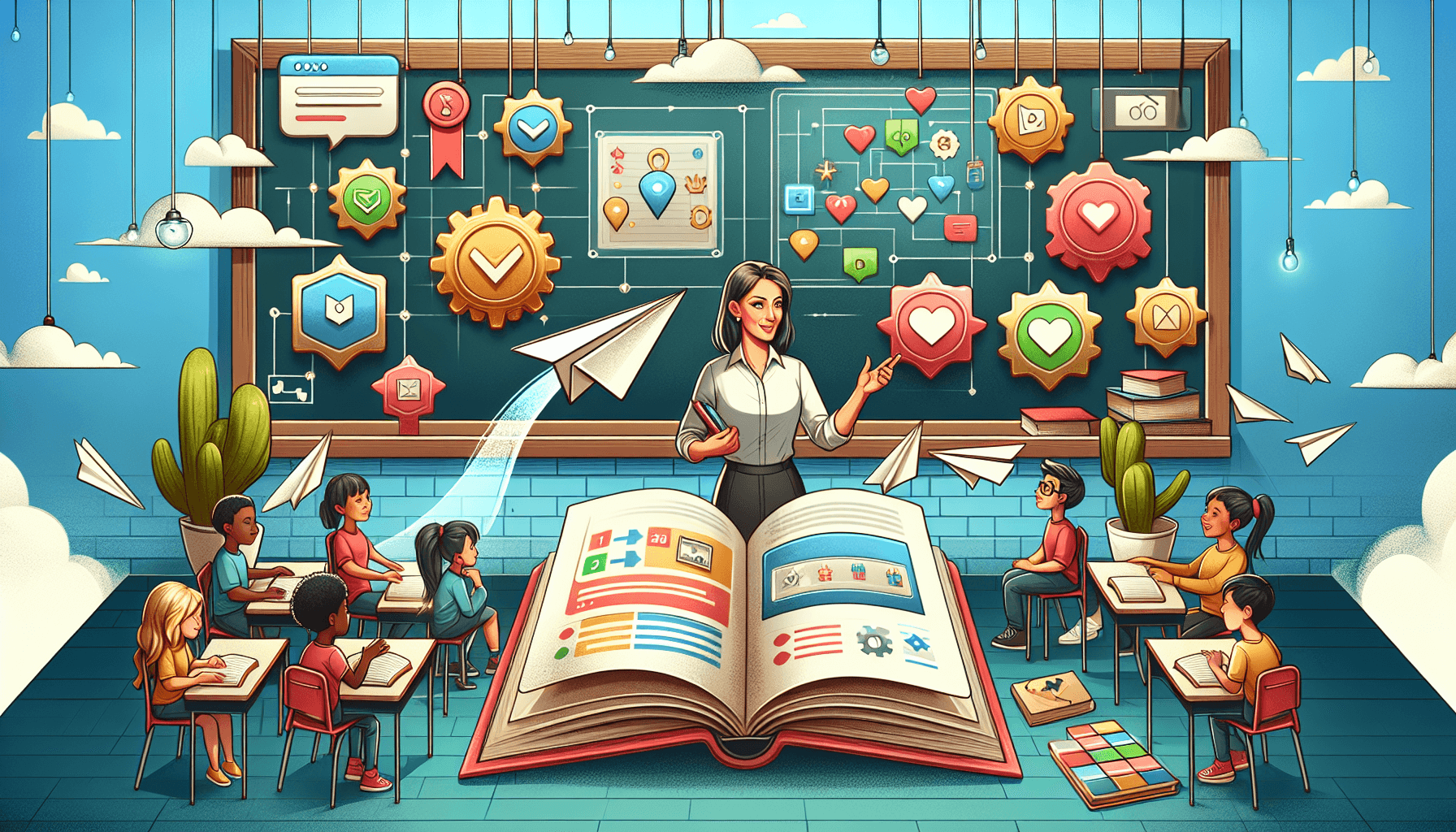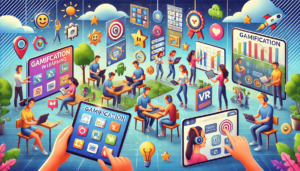In an era where attention is as scarce as it is sought after, gamification in learning emerges as a pivotal strategy to captivate and educate simultaneously. By integrating game design elements into educational content, gamification enriches the learning experience, making it both engaging and effective. This approach not only boosts motivation among learners but also enhances retention and application of knowledge. The importance of gamification in learning cannot be overstated as it revolutionizes traditional training methods, transforming them into interactive experiences that appeal to a wide range of learners.
The subsequent sections of this article delve into the nuances of gamification in training, outlining practical steps to integrate gamification into your training initiatives, encompassing strategies for successful gamification, and examining case studies of effective implementation. This roadmap provides educators and trainers with a comprehensive guide to creating engaging training content that not only educates but also entertains. By the end, readers will be well-equipped with the insights needed to harness the full potential of gamification in learning, offering an innovative solution to the challenge of maintaining learner engagement in an increasingly distracted world.
Overview of Gamification in Training
Definition and Importance
Gamification in education represents a transformative shift by integrating game elements like challenges, rewards, and leaderboards into learning environments. This approach, known as gamified learning or the gamification of learning, not only makes learning more engaging but also enhances student motivation and academic performance. By incorporating elements such as points and badges, learning gamification introduces a competitive yet fun element to education, encouraging students to engage deeply with the content and achieve higher levels of comprehension and retention.
How it Transforms Learning
Gamification for learning alters the traditional learning process by making it interactive and enjoyable. It leverages game mechanics such as instant feedback and immersive challenges, which are crucial for keeping students engaged and motivated. These elements help students understand the impact of their decisions immediately, fostering a better learning environment that accommodates various learning styles.
Moreover, by providing a platform for cooperation and collaboration, gamification and learning allow students to not only compete but also work together, enhancing both individual and collective learning experiences. The use of modern technologies like AR and VR further enriches this interactive learning landscape, making complex subjects more accessible and enjoyable.
Through gamifying learning, educators are able to create a dynamic learning environment that is not only aligned with modern educational needs but also effective in maintaining high engagement levels among students in the classroom.
Steps to Gamify Your Training
Review Current Training Materials
To effectively implement gamification strategies in your training, start by examining existing training materials. Identify areas where game elements could enhance engagement and learning outcomes. This might include integrating points, badges, or leaderboards at key learning milestones or transforming complex training sessions into a series of smaller, manageable challenges, similar to levels in an interactive game. This approach not only makes the training more interactive but also allows for the gradual building of knowledge and skills.
Incorporate Gamification Elements
Once you have identified potential areas for gamification techniques, strategically incorporate game mechanics such as points, badges, and leaderboards. These gamification examples should be aligned with clear learning objectives and outcomes to ensure they contribute meaningfully to the training experience. For instance, points could be awarded for completing tasks or mastering new skills, and badges could recognize achievements or milestones. Leaderboards can foster a healthy competitive environment, encouraging learners to engage more deeply with the content while promoting a sense of accomplishment and progress.
Engage Learners with Challenges and Rewards
Challenges and rewards are crucial gamification benefits in keeping learners motivated throughout the training process. Design challenges that are directly tied to real-world applications of the skills being taught, which helps in reinforcing knowledge and improving retention. Rewards, whether tangible or intangible, should be linked to specific achievements to maintain high levels of engagement. For example, completing a difficult section could unlock additional content or earn a badge, providing immediate feedback and recognition of the learner’s effort and success. This not only enhances the learning experience but also encourages continuous participation and progression in the training program.
Strategies for Successful Gamification
Setting Clear Objectives
Effective gamification in learning and development begins with well-defined objectives. It’s crucial to align game elements with the learning goals to ensure that each activity contributes to the overall educational outcomes. Establishing SMART goals—specific, measurable, achievable, relevant, and time-bound—provides a clear roadmap for both learners and instructors. This structured approach not only clarifies the purpose of each gamified component but also sets a measurable framework for assessing progress and success.
Monitoring and Adjusting Strategies
To maximize the impact of gamification in the classroom, continuous monitoring and adjustment of strategies based on learner feedback and performance data are essential. Regular evaluation allows educators to refine game mechanics and learning activities to better meet the needs of their audience. Collecting both quantitative and qualitative data, such as completion rates and learner satisfaction, helps in making informed decisions that enhance the learning experience and drive better engagement and retention.
Encouraging Collaboration
Gamification of education should also foster a sense of community and collaboration among learners. Integrating social interactions and collaborative challenges not only makes the learning process more enjoyable but also promotes knowledge sharing and team building. This approach leverages the social learning theory, which emphasizes that people learn effectively from one another. By encouraging teamwork, gamification not only enhances individual learning outcomes but also builds a supportive learning environment.
Case Studies of Successful Implementation
Sally Beauty Supply: Retail Sales Training
Sally Beauty Supply recognized the need to enhance the skills of their store associates to boost customer confidence and loyalty, particularly in the hair color and care sector. By partnering with Roundtable Learning, they developed highly interactive, gamified eLearning modules. These modules were designed to be deeply engaging, featuring scenario-based games and knowledge checks that provided instant feedback. This approach allowed associates to practice real-life situations, enhancing their ability to assist customers effectively. The training proved to be a success, with one product line selling out within 48 hours of launching the new curriculum.
Roland: Sales Training
Roland faced challenges in maintaining the effectiveness and enjoyment of their sales training, especially during the shift to online platforms due to the pandemic. By implementing a gamified approach through TalentLMS, a learning gamification platform, Roland not only maintained but enhanced the engagement of their training programs. They introduced weekly competitions and maintained leaderboards to celebrate achievements, ensuring that the training remained fun and engaging. This approach helped in keeping the training from becoming a chore, thus maintaining high participation and effectiveness.
PwC: Recruitment Process Gamification
PwC Hungary innovatively used gamification to engage job candidates through a game called Multipoly, which simulates the experience of working at the firm. This sales simulation allowed candidates to solve real-world business problems, enhancing their readiness for actual job roles. The results were impressive, with a 190% growth in job candidates and 78% of users expressing increased interest in working at PwC. Candidates who played Multipoly were reported to be better prepared for interviews and found the onboarding process easier, as they were already familiar with the company’s culture and expectations.
Conclusion
Throughout this article, we have delved into the transformative power of gamification in learning, exploring its capacity to revitalize traditional training methods by infusing them with engagement, motivation, and effectiveness. From the foundational principles and benefits of gamification to practical steps for incorporation and successful strategies, we’ve seen how gamification can create immersive, interactive learning experiences that cater to a diverse array of learning styles and objectives. The success stories of Sally Beauty Supply, Roland, and PwC serve as concrete gamification examples of how gamification, when executed thoughtfully, can yield significant outcomes in terms of engagement, knowledge retention, and application.
As we summarize our insights, it’s crucial to remember the essence of gamification is not merely to entertain but to enhance the educational journey, creating a compelling learning environment that motivates and engages learners. The strategies and case studies highlighted underscore the importance of clear objectives, continuous feedback, and the fostering of cooperation among learners. With the landscape of training and education continually evolving, elearning gamification stands out as a vibrant, impactful approach to crafting educational experiences that are not only instructive but also enjoyably memorable. As educators and trainers look to the future, gamification in elearning offers a promising path to enrich learning experiences, encouraging a deeper connection with the content and fostering a lively learning community.
FAQs
- How can you incorporate gamification into learning materials?
To gamify learning content effectively, consider integrating various elements such as storytelling, appealing visual design, and interactive competitions. Challenges and rewards can be used to motivate learners, while feedback mechanisms help them track their progress. Implementing gamified quizzes with badges or creating game-like quizzes focused on product knowledge are practical approaches. - What strategies can be employed to captivate learners through gamification?
Gamification enhances the learning experience by introducing game-like elements such as points, badges, leaderboards, levels, and challenges into educational activities. This approach makes the learning process more interactive and enjoyable, thereby increasing motivation and engagement among learners. - What are the two main types of gamification training to keep learners engaged?
The two primary types of gamification in training are content gamification and performance gamification. Content gamification is ideal when there is existing learning material that could be made more interactive and engaging. Performance gamification involves adding game elements like levels and challenge modes to enhance the training experience. - How does gamification boost learner engagement?
To increase engagement through gamification, it’s crucial to set clear objectives and goals, understand the audience, and incorporate both intrinsic and extrinsic rewards. An intuitive design and user experience, balanced challenge levels, ongoing tracking of feedback and progress, social interactions, competition, and personalized experiences are best practices that help boost engagement.


